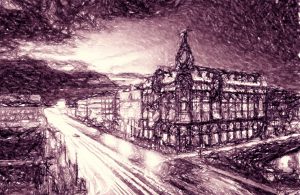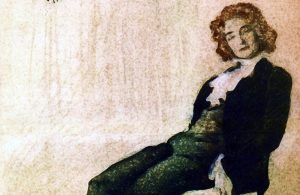A woman of Russian poetic symbolism, between exaltation and denigration



 There are beautiful bronze sculptures and the glass roofed atrium. At the intersection of the Nevsky Prospekt and the Griboyedov Canal, you will find a richly decorated art nouveau style building. It is the Singer Building http://www.spbdk.ru/. Its interior you offer art nouveau decorations and books. Once you have worn yourself out, you can relax at Singer Cafe, without forget buy a book by Zinaida Gippius and enjoy your views of the Prospekt.
There are beautiful bronze sculptures and the glass roofed atrium. At the intersection of the Nevsky Prospekt and the Griboyedov Canal, you will find a richly decorated art nouveau style building. It is the Singer Building http://www.spbdk.ru/. Its interior you offer art nouveau decorations and books. Once you have worn yourself out, you can relax at Singer Cafe, without forget buy a book by Zinaida Gippius and enjoy your views of the Prospekt.



 Zinaida Gippius https://russiapedia.rt.com/prominent-russians/literature/zinaida-hippius/ was born in Belëv on a day in November 1869. Poet and essayist, she became a well-known representative of Russian symbolism. Thanks to her frequent interventions at literary evenings during which she read her verses, all St. Petersburg had learned about that slender blonde-haired person with golden hair who enchanted him with his emerald eyes.
Zinaida Gippius https://russiapedia.rt.com/prominent-russians/literature/zinaida-hippius/ was born in Belëv on a day in November 1869. Poet and essayist, she became a well-known representative of Russian symbolism. Thanks to her frequent interventions at literary evenings during which she read her verses, all St. Petersburg had learned about that slender blonde-haired person with golden hair who enchanted him with his emerald eyes.



 Zinaida Gippius https://epistemepassion.blogspot.com/zinaida-gippius was born in a small town in Central Russia to a noble German family. During her adolescence, she suffered from tuberculosis, therefore forced to move in search of a milder climate, following studies that would lead her to read all the Russian classics. In 1888, she met the poet Dmitrij Merežkovskij and published her first verses in a magazine of Petersburg symbolists. In 1889, Zinaida Gippius https://www.amazon.it/green-ring-play-four-acts/dp/B0041D9QCU/ref=sr_1_4?qid=1581496721&refinements=p_27%3AZinaida+Gippius&s=books&sr=1-4 married, moving to St. Petersburg, where her house would become a meeting place for writers and artists. She published biting literary essays, using the pseudonym of Anton Krajnij. Becoming revolutionary, she wrote political themed verses, which, due to her attitude, forced her to immigrate to Paris, where she lived in poverty and died on a day in September 1945.
Zinaida Gippius https://epistemepassion.blogspot.com/zinaida-gippius was born in a small town in Central Russia to a noble German family. During her adolescence, she suffered from tuberculosis, therefore forced to move in search of a milder climate, following studies that would lead her to read all the Russian classics. In 1888, she met the poet Dmitrij Merežkovskij and published her first verses in a magazine of Petersburg symbolists. In 1889, Zinaida Gippius https://www.amazon.it/green-ring-play-four-acts/dp/B0041D9QCU/ref=sr_1_4?qid=1581496721&refinements=p_27%3AZinaida+Gippius&s=books&sr=1-4 married, moving to St. Petersburg, where her house would become a meeting place for writers and artists. She published biting literary essays, using the pseudonym of Anton Krajnij. Becoming revolutionary, she wrote political themed verses, which, due to her attitude, forced her to immigrate to Paris, where she lived in poverty and died on a day in September 1945.

 LOVE IS ONE – It boils only once and foam, and its wave spreads. He cannot live the heart of treason, and treason is not: love is one. We get angry, play, tell the fake, but our heart is silent. We do not know how to betray, and do not betray. The soul is unique. Love is unique. Monotony and desolation. From monotony, drawing strength, life flows, and lasting life. Love is one, one and always one. In the immutable alone is the infinite, only in the assiduous depth. Life is long; eternity is near, it is increasingly clear that love is one. Love repays with blood, but the faithful soul remains faithful, and we love only one love, one is love, as death is one.
LOVE IS ONE – It boils only once and foam, and its wave spreads. He cannot live the heart of treason, and treason is not: love is one. We get angry, play, tell the fake, but our heart is silent. We do not know how to betray, and do not betray. The soul is unique. Love is unique. Monotony and desolation. From monotony, drawing strength, life flows, and lasting life. Love is one, one and always one. In the immutable alone is the infinite, only in the assiduous depth. Life is long; eternity is near, it is increasingly clear that love is one. Love repays with blood, but the faithful soul remains faithful, and we love only one love, one is love, as death is one.
If you want to know writers, you can type http://meetingbenches.com/category/library/, while for poets around the world http://meetingbenches.com/category/poetry/. The sole purpose of this site is to spread the knowledge of these artists and that other people enjoy their works. The property of the images that appear in this blog correspond to their authors.







